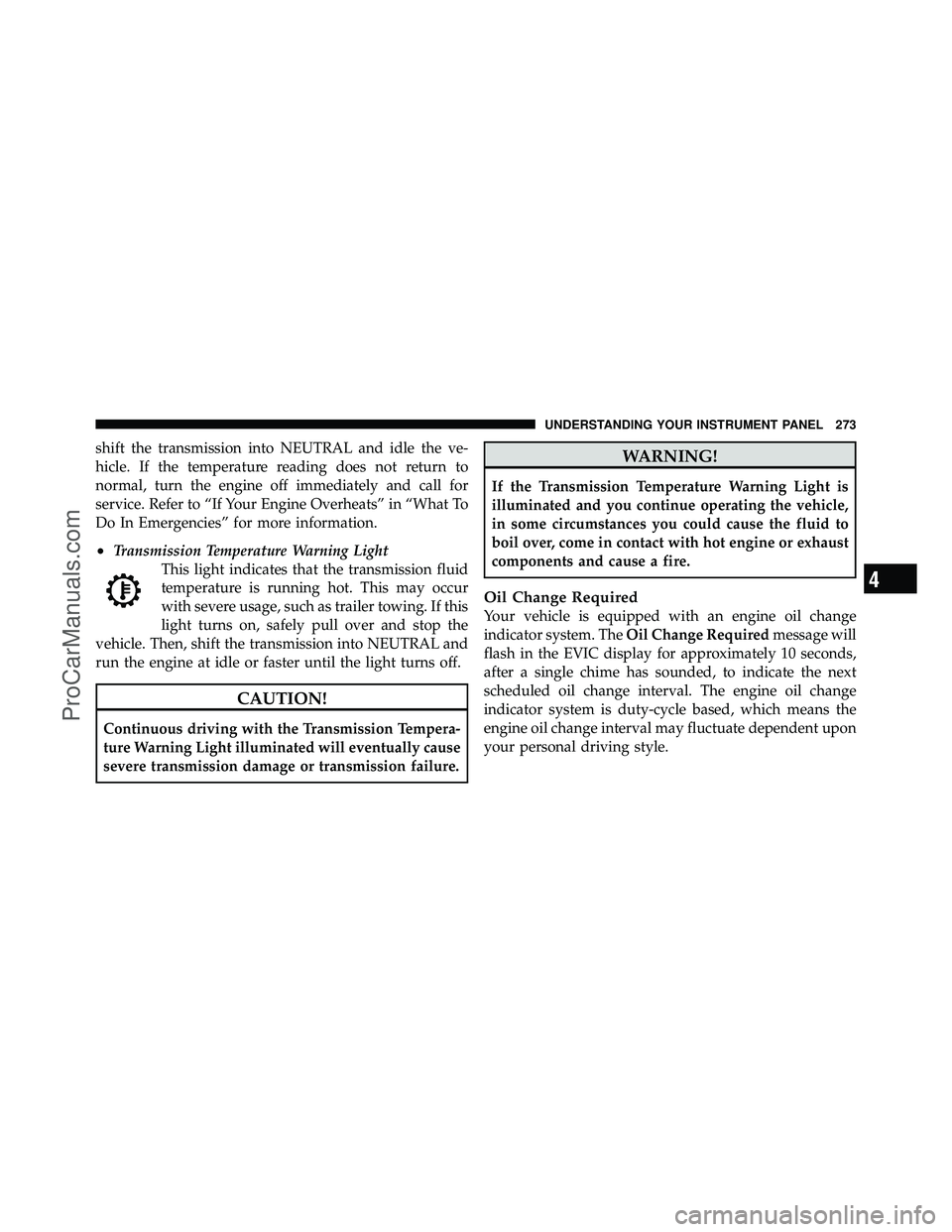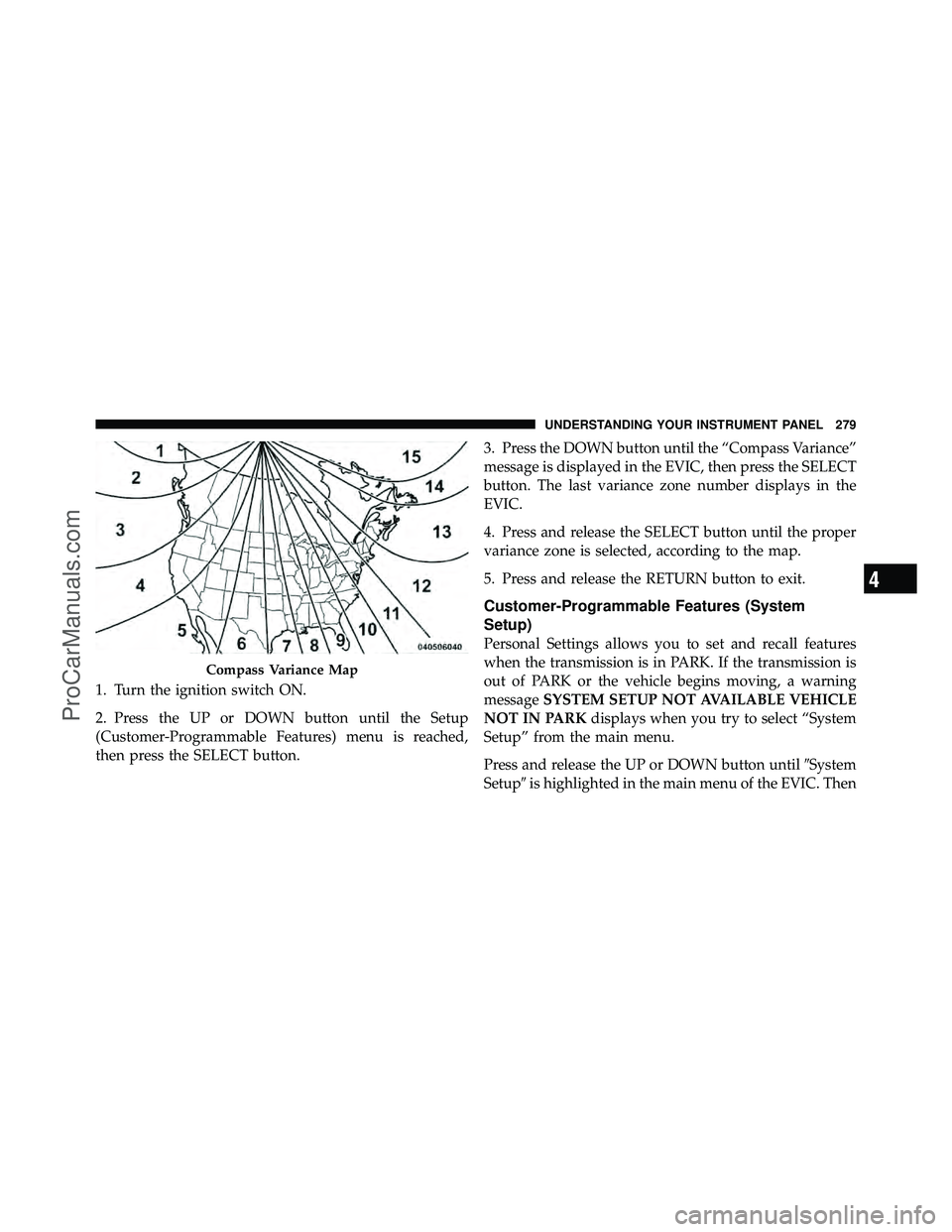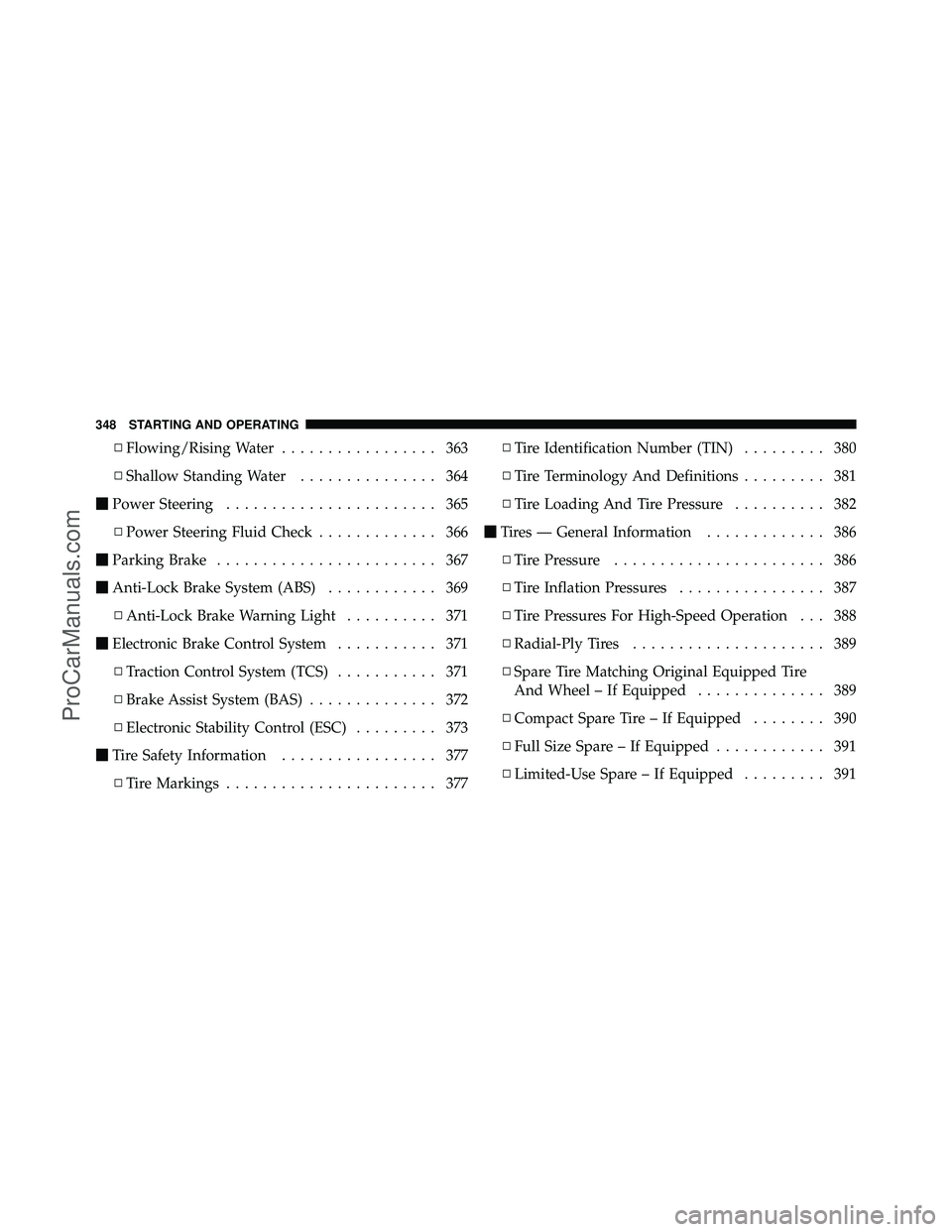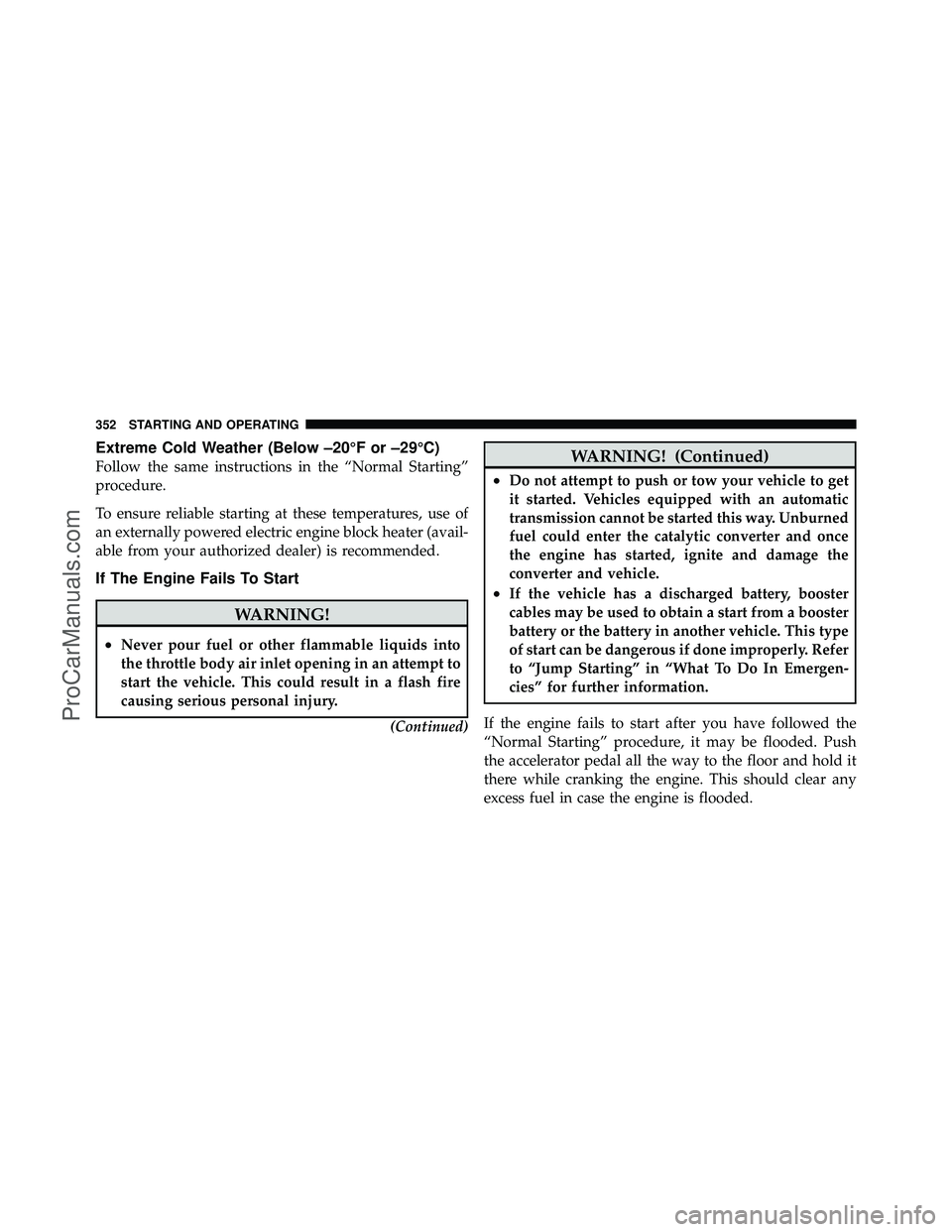Page 275 of 562

shift the transmission into NEUTRAL and idle the ve-
hicle. If the temperature reading does not return to
normal, turn the engine off immediately and call for
service. Refer to “If Your Engine Overheats” in “What To
Do In Emergencies” for more information.
•Transmission Temperature Warning LightThis light indicates that the transmission fluid
temperature is running hot. This may occur
with severe usage, such as trailer towing. If this
light turns on, safely pull over and stop the
vehicle. Then, shift the transmission into NEUTRAL and
run the engine at idle or faster until the light turns off.
CAUTION!
Continuous driving with the Transmission Tempera-
ture Warning Light illuminated will eventually cause
severe transmission damage or transmission failure.
WARNING!
If the Transmission Temperature Warning Light is
illuminated and you continue operating the vehicle,
in some circumstances you could cause the fluid to
boil over, come in contact with hot engine or exhaust
components and cause a fire.
Oil Change Required
Your vehicle is equipped with an engine oil change
indicator system. The Oil Change Required message will
flash in the EVIC display for approximately 10 seconds,
after a single chime has sounded, to indicate the next
scheduled oil change interval. The engine oil change
indicator system is duty-cycle based, which means the
engine oil change interval may fluctuate dependent upon
your personal driving style.
4
UNDERSTANDING YOUR INSTRUMENT PANEL 273
ProCarManuals.com
Page 281 of 562

1. Turn the ignition switch ON.
2. Press the UP or DOWN button until the Setup
(Customer-Programmable Features) menu is reached,
then press the SELECT button.3. Press the DOWN button until the “Compass Variance”
message is displayed in the EVIC, then press the SELECT
button. The last variance zone number displays in the
EVIC.
4. Press and release the SELECT button until the proper
variance zone is selected, according to the map.
5. Press and release the RETURN button to exit.
Customer-Programmable Features (System
Setup)
Personal Settings allows you to set and recall features
when the transmission is in PARK. If the transmission is
out of PARK or the vehicle begins moving, a warning
message
SYSTEM SETUP NOT AVAILABLE VEHICLE
NOT IN PARK displays when you try to select “System
Setup” from the main menu.
Press and release the UP or DOWN button until �System
Setup� is highlighted in the main menu of the EVIC. Then
Compass Variance Map
4
UNDERSTANDING YOUR INSTRUMENT PANEL 279
ProCarManuals.com
Page 318 of 562

WARNING!
Do not plug in or remove the iPod�or external USB
device while driving. Failure to follow this warning
could result in an accident.
Bluetooth Streaming Audio (BTSA)
Music can be streamed from your cellular phone to the
Uconnect™ phone system.
Controlling BTSA Using Radio Buttons
To get into the BTSA mode, press either “AUX” button on
the radio or press the VR button and say “Bluetooth
Streaming Audio”.
Play Mode
When switched to BTSA mode, some audio devices can
start playing music over the vehicle’s audio system, but
some devices require the music to be initiated on the
device first, then it will get streamed to the Uconnect™ phone system. Seven devices can be paired to the
Uconnect™ phone system, but just one can be selected
and played.
Selecting Different Audio Device
1. Press PHONE button to begin.
2. After the
�Ready�prompt and the following beep, say
�Setup�, then �Select Audio Devices�.
3. Say the name of the audio device or ask the
Uconnect™ phone system to list audio devices.
Next Track
Use the SEEK UP button, or press the VR button on the
radio and say “Next Track” to jump to the next track
music on your cellular phone.
316 UNDERSTANDING YOUR INSTRUMENT PANEL
ProCarManuals.com
Page 350 of 562

▫Flowing/Rising Water ................. 363
▫ Shallow Standing Water ............... 364
� Power Steering ....................... 365
▫ Power Steering Fluid Check ............. 366
� Parking Brake ........................ 367
� Anti-Lock Brake System (ABS) ............ 369
▫ Anti-Lock Brake Warning Light .......... 371
� Electronic Brake Control System ........... 371
▫ Traction Control System (TCS) ........... 371
▫ Brake Assist System (BAS) .............. 372
▫ Electronic Stability Control (ESC) ......... 373
� Tire Safety Information ................. 377
▫ Tire Markings ....................... 377 ▫
Tire Identification Number (TIN) ......... 380
▫ Tire Terminology And Definitions ......... 381
▫ Tire Loading And Tire Pressure .......... 382
� Tires — General Information ............. 386
▫ Tire Pressure ....................... 386
▫ Tire Inflation Pressures ................ 387
▫ Tire Pressures For High-Speed Operation . . . 388
▫ Radial-Ply Tires ..................... 389
▫ Spare Tire Matching Original Equipped Tire
And Wheel – If Equipped .............. 389
▫ Compact Spare Tire – If Equipped ........ 390
▫ Full Size Spare – If Equipped ............ 391
▫ Limited-Use Spare – If Equipped ......... 391
348 STARTING AND OPERATING
ProCarManuals.com
Page 351 of 562

▫Tire Spinning ....................... 392
▫ Tread Wear Indicators ................. 393
▫ Life Of Tire ........................ 393
▫ Replacement Tires .................... 394
� Tire Chains .......................... 395
� Snow Tires .......................... 397
� Tire Rotation Recommendations ........... 397
� Tire Pressure Monitor System (TPMS) ....... 398
▫ Base System ........................ 401
▫ Premium System – If Equipped .......... 403
� Fuel Requirements ..................... 408
▫ 3.6L Engine ........................ 408
▫ Reformulated Gasoline ................ 408 ▫
Gasoline/Oxygenate Blends ............. 409
▫ E-85 Usage In Non-Flex Fuel Vehicles ...... 409
▫ MMT In Gasoline .................... 410
▫ Materials Added To Fuel ............... 410
▫ Fuel System Cautions ................. 411
▫ Carbon Monoxide Warnings ............ 412
� Flexible Fuel — If Equipped .............. 412
▫ E-85 General Information ............... 412
▫ Ethanol Fuel (E-85) ................... 414
▫ Fuel Requirements ................... 414
▫ Selection Of Engine Oil For Flexible Fuel
Vehicles (E-85) And Gasoline Vehicles ...... 415
▫ Starting ........................... 415
5
STARTING AND OPERATING 349
ProCarManuals.com
Page 353 of 562

STARTING PROCEDURES
Before starting your vehicle, adjust your seat, adjust the
inside and outside mirrors, fasten your seat belt, and if
present, instruct all other occupants to buckle their seat
belts.
WARNING!
Never leave unattended children alone in a vehicle.
Leaving children in a vehicle is dangerous for a
number of reasons. A child or others could be seri-
ously or fatally injured. Do not leave the key fob in
the ignition switch. A child could operate power
windows, other controls, or move the vehicle.
Automatic Transmission
The shift lever must be in the NEUTRAL or PARK
position before you can start the engine. Press the brake
pedal before shifting into any driving gear.
Normal Starting
1. Do not press the accelerator.
2. Use the Fob with Integrated Key to briefly turn the
ignition switch to the START position and release it as
soon as the starter engages. The starter motor will
continue to run, and it will disengage automatically
when the engine is running.
3. If the engine fails to start, the starter will disengage
automatically in 10 seconds. If this occurs, turn the
ignition switch to the OFF position, wait 10 to 15 seconds,
then repeat the “Normal Starting” procedure (Steps 1–3
above).
NOTE: This vehicle is equipped with a transmission
shift interlocking system. The brake pedal must be
pressed to shift out of PARK.
5
STARTING AND OPERATING 351
ProCarManuals.com
Page 354 of 562

Extreme Cold Weather (Below –20°F or –29°C)
Follow the same instructions in the “Normal Starting”
procedure.
To ensure reliable starting at these temperatures, use of
an externally powered electric engine block heater (avail-
able from your authorized dealer) is recommended.
If The Engine Fails To Start
WARNING!
•Never pour fuel or other flammable liquids into
the throttle body air inlet opening in an attempt to
start the vehicle. This could result in a flash fire
causing serious personal injury.(Continued)
WARNING! (Continued)
•Do not attempt to push or tow your vehicle to get
it started. Vehicles equipped with an automatic
transmission cannot be started this way. Unburned
fuel could enter the catalytic converter and once
the engine has started, ignite and damage the
converter and vehicle.
•If the vehicle has a discharged battery, booster
cables may be used to obtain a start from a booster
battery or the battery in another vehicle. This type
of start can be dangerous if done improperly. Refer
to “Jump Starting” in “What To Do In Emergen-
cies” for further information.
If the engine fails to start after you have followed the
“Normal Starting” procedure, it may be flooded. Push
the accelerator pedal all the way to the floor and hold it
there while cranking the engine. This should clear any
excess fuel in case the engine is flooded.
352 STARTING AND OPERATING
ProCarManuals.com
Page 356 of 562

WARNING!
Remember to disconnect the engine block heater
cord before driving. Damage to the 110-115 Volt
electrical cord could cause electrocution.
AUTOMATIC TRANSMISSION
CAUTION!
Damage to the transmission may occur if the follow-
ing precautions are not observed:
•Move the shift lever into PARK only after the
vehicle has come to a complete stop.
•Do not move the shift lever from REVERSE,
PARK, or NEUTRAL into any forward gear when
the engine is above idle speed.
•Before moving the shift lever into any gear, make
sure your foot is firmly on the brake pedal.NOTE:
You must press and hold the brake pedal down
while shifting out of PARK.
WARNING!
It is dangerous to move the shift lever out of PARK or
NEUTRAL if the engine speed is higher than idle
speed. If your foot is not firmly on the brake pedal,
the vehicle could accelerate quickly forward or in
reverse. You could lose control of the vehicle and hit
someone or something. Only shift into gear when the
engine is idling normally and when your foot is
firmly on the brake pedal.
354 STARTING AND OPERATING
ProCarManuals.com